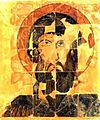Early Middle Ages facts for kids
The powerful Roman Empire once ruled a huge part of Europe. But in 476, it became weak and finally fell apart. When this happened, its army stopped protecting people. Also, ways for people to talk to each other across long distances broke down. This meant people in Europe couldn't easily share news or information.
The Roman army used to keep peace and defend Europe from invaders. With no army, there was a lot of fighting. This difficult time was called the Dark Ages. A famous person from this period is King Arthur of England. We don't know if he was a real person or just a legend. But the story says he brought peace to England during this time.
After the Dark Ages came the Middle Ages. It's called the middle ages because it was between ancient history and modern history. You might also hear it called medieval times. During this period, most of Europe was Christian. The Catholic Church was very powerful and important.
The Middle Ages ended when the Renaissance began. The Renaissance was a time when people started going to school and university more. They learned many new things. There was also less fighting. A very important invention during this time was the printing press. This machine made it easy and fast to create books. This helped many more people read and learn.
Images for kids
-
A gold plate, called a paten, found in France. It is from the Treasure of Gourdon.
-
Empress Theodora, wife of Emperor Justinian, and her helpers in a mosaic.
-
An ivory carving from about 945 showing Christ crowning Constantine VII.
-
The Sutton Hoo helmet, an Anglo-Saxon helmet from the early 7th century.
-
The Gokstad ship, a 9th-century Viking longship. It was found in 1882 and is now in a museum in Oslo, Norway.
-
St. Michael's Church, Hildesheim, built in the 1010s. Its style was inspired by older Roman and Byzantine buildings.
See also
 In Spanish: Alta Edad Media para niños
In Spanish: Alta Edad Media para niños












